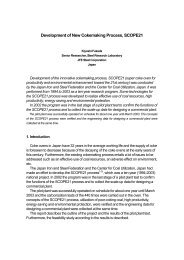Defining CCS Ready: An Approach to An International Definition
Defining CCS Ready: An Approach to An International Definition
Defining CCS Ready: An Approach to An International Definition
- No tags were found...
Create successful ePaper yourself
Turn your PDF publications into a flip-book with our unique Google optimized e-Paper software.
Chapter 3: Transport <strong>Ready</strong> Plant <strong>Definition</strong>Institute, US DOE/NETL, MIT, and IEAGHG have prepared lists of identified CO 2 captureprojects across the world, which can be used <strong>to</strong> identify possible vendors and partners for<strong>CCS</strong> projects. 80 Exhibit 3-5 lists the types of equipment for consideration by developers thatwish <strong>to</strong> construct their own CO 2 transport pipeline.Exhibit 3-5: Key Equipment for CO 2 Transport Pipeline• Line Pipe• Valves• Compressors• Booster pumps• Pig launchers and receivers• Batching stations and instrumentation• Metering stations• Supervisory Control and Data Acquisition (SCADA)systemsSource: WRI 81Early consideration of the companies and infrastructure (e.g., a CO 2 trunk line) that areavailable will help companies determine which type of commercial arrangement they mightneed. Options may include a private contract with a single carrier, aligning with other plan<strong>to</strong>pera<strong>to</strong>rs and s<strong>to</strong>rage facilities <strong>to</strong> contract with a pipeline company that will build andoperate the pipeline, or potentially working with government cooperation.As discussed in Section 2.4.4, identifying partners in advance will provide a variety ofbenefits, including promoting acquisition of business procurement agreements, buildingrelationships, promoting knowledge sharing, and minimizing delays in obtaining equipmentand services at the time of retrofit.3.3.5 Maintaining Transport ReadinessAs mentioned in section 2.4.5, a <strong>CCS</strong> deployment plan requires regular assessments of aplant’s transport readiness status. Future barriers <strong>to</strong> <strong>CCS</strong> deployment can be addressed bybeing Transport <strong>Ready</strong> and maintaining this status. Obligations for transport readinessinclude ensuring that:• Economic development and land use changes do not prevent use of previously identifiedroutes and modes of transport;• Changes <strong>to</strong> environmental and safety regulations do not complicate plans <strong>to</strong> transportCO 2 ;• Cheaper and safer available modes of transport are identified when possible;• Selected transport technology is still relevant and valid given plant specifics, and nomajor modifications have been made that would make it inapplicable;80 References include:– Global <strong>CCS</strong> Institute. (2009a). Strategic analysis of the global status of carbon capture and s<strong>to</strong>rage. Report 1: Status ofcarbon capture and s<strong>to</strong>rage projects globally (Final Report). Canberra ACT, Australia: Author.– U.S. Department of Energy, National Energy Technology Labora<strong>to</strong>ry (U.S. DOE-NETL). (2010). Carbon sequestration:NETL carbon capture and s<strong>to</strong>rage database.– Massachusetts Institute of Technology (MIT). (2010). Carbon dioxide capture and s<strong>to</strong>rage project database.– <strong>International</strong> Energy Agency Greenhouse Gas R&D Programme (IEA GHG). (n.d.) R, D&D projects database.81 World Resources Institute (WRI). (2008). <strong>CCS</strong> Guidelines: Guidelines for carbon dioxide capture, transport, and s<strong>to</strong>rage.Washing<strong>to</strong>n, DC: Author.23 February 2010 45
















